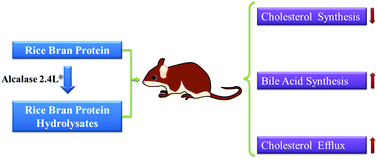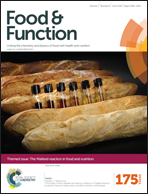Rice bran proteins and their hydrolysates modulate cholesterol metabolism in mice on hypercholesterolemic diets
Abstract
The hypolipidemic properties of defatted rice bran protein (DRBP), fresh rice bran protein (FRBP), DRBP hydrolysates (DRBPH), and FRBP hydrolysates (FRBPH) were determined in mice on high fat diets for four weeks. Very low-density lipoprotein cholesterol (VLDL-C), low-density lipoprotein cholesterol (LDL-C) contents, and the hepatic total cholesterol content were reduced while fecal total cholesterol and total bile acid (TBA) contents were increased in the FRBPH diet group. The expression levels of hepatic genes for cholesterol biosynthesis HMG-CoAR and SREBP-2 were lowest in the FRBPH diet group. The mRNA level of HMG-CoAR was significantly positively correlated with the hepatic TG content (r = 0.82, P < 0.05). The mRNA levels of genes related to bile acid biosynthesis and cholesterol efflux, CYP7A1, ABCA1, and PPARγ were up-regulated in all test groups. The results suggest that FRBPH regulates cholesterol metabolism in mice fed the high fat and cholesterol diet by increasing fecal steroid excretion and expression levels of genes related to bile acid synthesis and cholesterol efflux, and the down-regulation of the expression levels of genes related to cholesterol biosynthesis.


 Please wait while we load your content...
Please wait while we load your content...